How to LST Cannabis Plants
An in-depth tutorial on how to low-stress train indoor or outdoor cannabis plants.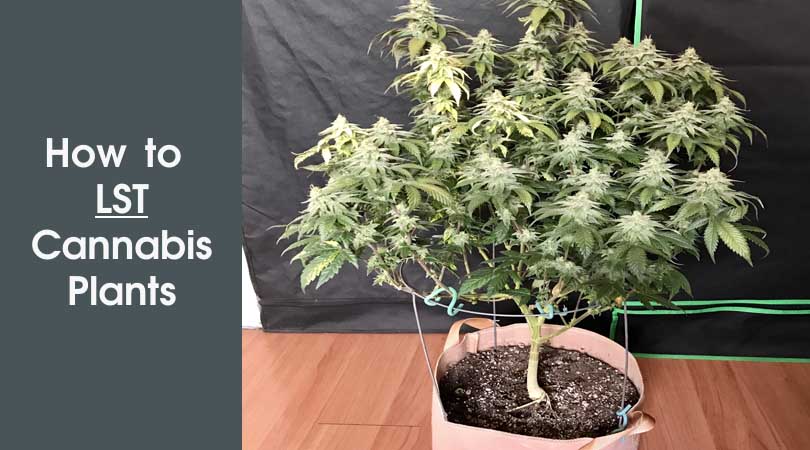 When it comes to cannabis cultivation — it’s all about maximizing your yield.
When it comes to cannabis cultivation — it’s all about maximizing your yield.
As a beginner, however, you may feel lost regarding boosting your yield while navigating the rough waters of growing weed.
Luckily for you — our low-stress training tutorial exists.
Read along to learn how to LST marijuana plants in a few easy steps. Discover how a few plant ties can transform your marijuana crop into a bud producing machine.
Let’s go!
What is LST and Why You Should Use It
First and foremost, let’s give a brief recap of what LST is.
Low-stress training, also known as LST, is a non-invasive training technique that allows you to increase your overall yield. However, what does LST entail?
LST revolves around bending cannabis plants — specifically the branches.
Although it isn’t set in stone, the best time to perform LST is when cannabis plants are young. It’s best to perform LST on young marijuana plants because the branches and stems have yet to develop a callous layer fully.
However, why should you perform the LST method on your cannabis plants?
Well, the reasons are clear:
- Increases yield
- Breaks apical dominance
- Promotes light penetration
- Reduces overall height
- Ideal for cannabis cultivators in countries that limit plant count
If any of these aspects apply to you, it’s time to learn how to low-stress train your weed plants.
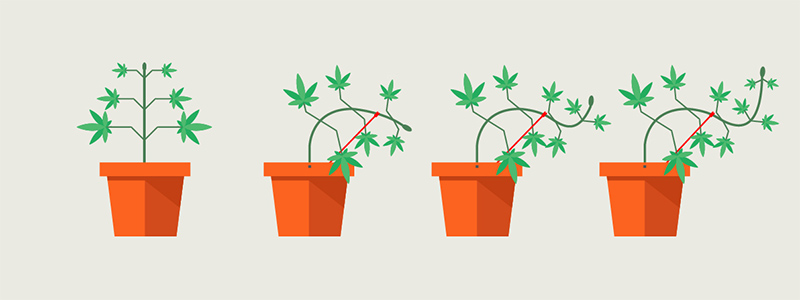
Here’s a simple visual guide for what LST is.
Q: What is Low-Stress Training (LST)?
A: Low-stress training, also known as LST, is a non-invasive training technique that allows you to increase your overall yield. LST revolves around bending cannabis plants — specifically the branches.
Will LST Stress Out My Plants?
No!
The whole point of low-stress training cannabis plants is to provide a gentle way to train branches. Unlike other marijuana training methods, LST allows weed plants to bounce back within 12-hours.
For those who don’t know, other forms of training methods require 24-48-hours for cannabis plants to continue growing. Therefore, low-stress training marijuana is ideal for beginners that don’t want to worry about hurting their weed plants.
Q: Will Low-Stress Training (LST) Stress Out My Plants?
A: No. The whole point of low-stress training cannabis plants is to provide a gentle way to train branches. Therefore, low-stress training marijuana is ideal for beginners that don’t want to worry about hurting their weed plants.
How to LST Marijuana Plants in Five Easy Steps
Ready to LST your feminized or autoflowering plants down?
Here’s a list of necessary tools for the job:
- Soft plant ties or rubber-coated plant wire
- Bamboo or wooden stakes
- Drill
- Duct tape or eco-friendly tape
When you look through this list of essential materials — do you notice anything? For starters, everything on the list is cheap. Second, everything on this list is readily found online or in a hardware store near you — simple!
Now, let’s move on to the meat and potatoes and learn how to LST autoflowering or feminized weed plants down.
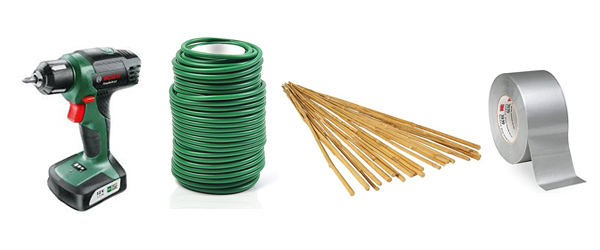
Here’s what you’ll need. However, you won’t need a drill if you’re using bamboo stakes.
Step One: Setting Up Anchor Points
First thing’s first — what container are you using to grow weed in?
If you’re using a plastic container, you’ll need a drill to puncture four or more holes around the rim. If you’re growing marijuana in a container that can’t be drilled, you may use bamboo or wooden stakes as an anchor point.
Once you’ve placed stakes in the media or drilled holes in the container, it’s time for step two.
Step Two: Bending Your Cannabis Plants
Next, the obvious question is when should I start the LST technique?
Your plants should be in the early vegetative stage. Remember — the earlier, the better. At this stage, you’ll perform the first bend.
To accomplish the first step of LST, you must:
- Locate the upper-most node
- Gently pull down the upper node towards an anchor point
- Use a plant tie or rubberized plant wire and anchor the top node to the anchor point
Remember — you must be incredibly gentle at this point. Never pull the plant down roughly or over-bend the plant, or you risk breaking the stem. We cannot stress the significance of gentleness enough — your weed plant’s life depends on it.
Your cannabis plant will adjust to low-stress training within 12-24-hours. At first, the plant is bent sideways, but soon, you’ll notice the upper-most node, along with lateral nodes, will begin to look up towards the light.
Lastly, if you break a branch, use the duct tape to re-establish a bond between the broken section and the point of breakage. Firmly wrap the fractured section with duct tape and allow the area to heal throughout 2-4-days.
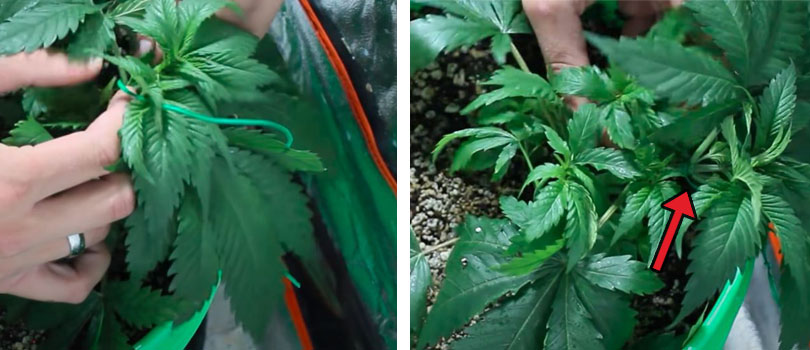
Take the uppermost node and gently tie it down to the pot or to an anchor point.
Step Three: Keep Bending As They Grow
Although step two could be the end of your LST journey, there are a few more steps to accomplish if you wish to continue.
After a few days of growth, you’ll notice that multiple cannabis branches seek to establish dominance. As the stems grow, you have the ideal chance to continue tying down branches to create an even canopy.
Therefore, step three requires you to:
- Bend and anchor dominant branches on the opposite end of the original anchor point
- Follow the same guidelines as step two
Remember, never overlap branches! The entire point of low-stress training weed plants is to disperse branches rather than allow them to bunch together.
Once complete, you may have one, two, or three new anchor points that pull branches in different directions. Remember, the overarching goal is to ensure an even canopy.
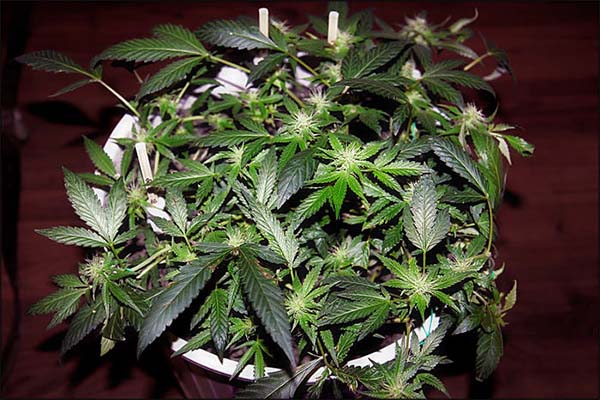
You want to disperse the branches and make sure they don’t overlap.
Step Four: Veg Out Your Plants
Now, let time do its thing.
Allow your cannabis plant(s) to grow and increase in size. At this point, you’ll notice that your cannabis plant is wide and bushy but not tall. By bending the branches, the inner section of the marijuana plant is wide open to light, which fuels rapid growth.
Depending on the desired size of the cannabis plant, you may allow your plants to vegetate for 2-6-weeks.
However, the longer you decide to veg, the more you’ll need to LST your cannabis plants to ensure an even canopy.
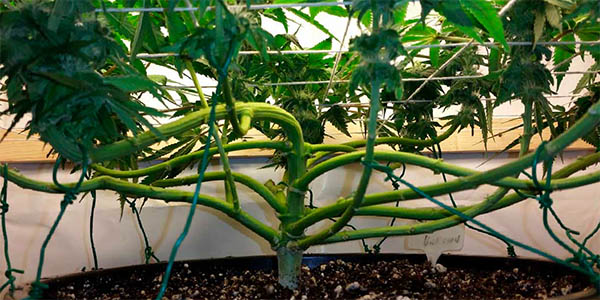
After vegging for a while, your plant will be ready to stack on weight.
Step Five: Enjoy Incredible Yields
At this point, it’s all about adjustments.
Your cannabis plant should have multiple and strategically placed anchor points. If you notice that one section is outgrowing the rest, it’s time to add another anchor to tie the branch down.
Once the flowering stage begins, it’s time to sit back and watch your cannabis plant stack on the weight. Since you opened the marijuana plant, the buds will fill out the top, middle, and lower sections with trichome-dusted flowers.
LST Your Marijuana Crop For Record-Busting Yields
We have yet to find a cannabis plant that doesn’t like getting tied down.
As such, this is a perfect training method for beginners and professionals alike. There’s nothing like watching a single marijuana plant yield as if it’s ten plants. In other words, don’t pout if you’re only able to grow one plant — the LST method will make it worth it.
Don’t believe us? Try low-stress training your marijuana crop today and watch the difference — you’ll be shocked by the results!
Learn About More Cannabis Training Methods:
